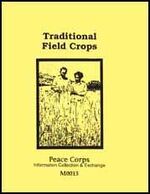Traditional Field Crops/Glossary
|
Crop rotation: |
The repetitive growing of an orderly succession of crops on the same field. |
|
Field trial: |
An on-farm trial repeated simultaneously on a number of local farms to compare a new practice or "package" of practices with the present practice or practices. It is designed to obtain information, not as a demonstration. |
|
Fungicide: |
Any pesticide that kills or halts the development of fungi. |
|
Herbicide: |
Any pesticide that kills weeds. |
|
Hybrid: |
A type of improved crop variety produced by crossing two or more inbred lines of a crop. |
|
Legume: |
Any plant belonging to the Leguminosae Family whose members all produce their seeds in pods. Legumes can satisfy part or all of their nitrogen needs through a symbiotic relationship with Rhizobia bacteria that form nodules on the roots. Beans, cowpeas soybeans, mungbeans, lima beans, chickpeas, pigeonpeas, and peas are legumes. |
|
Monoculture: |
The repetitive growing of a single crop on the same field year after year. |
|
Multiple cropping: |
The growing of two or more different crops at the same time on the same field: also referred to as intercropping. |
|
Nematodes: |
Tiny, colorless, threadlike roundworms that live in the soil and parasitize plant roots. |
|
Nitrogen fixation: |
The beneficial process by which Rhizobia bacteria convert atmospheric nitrogen into a usable form for plants. Rhizobia bacteria are associated only with legumes. |
|
Phosphorus fixation: |
The process by which added fertilizer phosphorus becomes tied-up as insoluble compounds in the soil and unavailable to plants. Phosphorus fixation is a problem on all soils but is especially severe on highly weathered, acid, red tropical soils. |
|
Pulse: |
A legume crop whose mature dry seeds are suitable for human consumption; examples are beans, cowpeas, soybeans, chickpeas, and mungbeans. |
|
Result test: |
See field trial. |
|
Rhizobia: |
A type of bacteria associated with legumes and capable of nitrogen fixation. |
|
Soil texture: |
The relative amount of sand, silt, and clay in a given soil. |
|
Soil filth: |
The current physical condition of a soil in terms of its workability and ease of moisture absorption. A soil's filth can vary markedly with its texture, humus content, and current moisture content. |
|
Systemic insecticide: |
An insecticide that is absorbed into the plant sap and translocated (transported) throughout the plant. |
|
Threshing: |
The process of separating the seeds of cereal and pulse crops from the seedheads, cobs or pods. |
|
Tillering: |
The production of sideshoots by a crop during its growth; tillering is common in millet and sorghum. |
|
Transpiration: |
The loss of soil moisture by plant root absorption and passage into the air through the leaf pores. |
|
Winnowing: |
The process of separating chaff and other light trash from threshed grain using wind, fandriven air or screens. |
